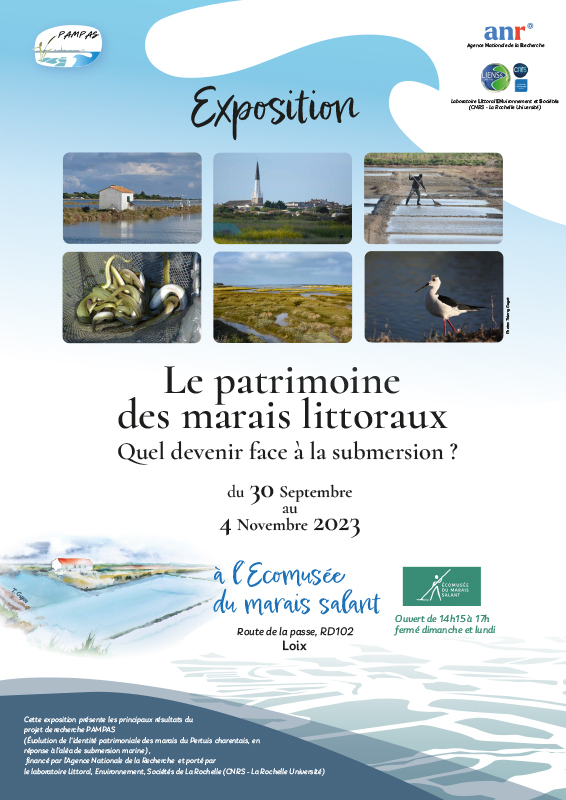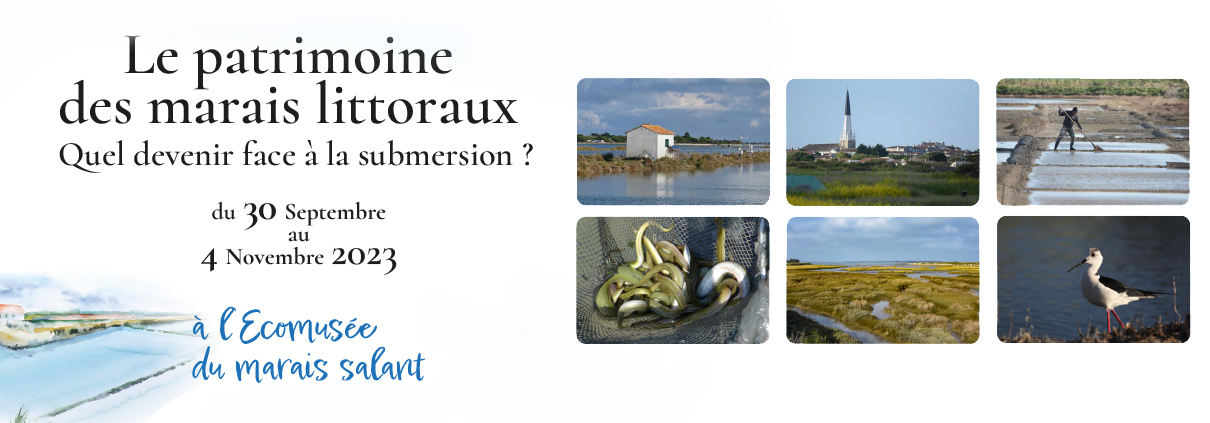PAMPAS project exhibition: Coastal marsh heritage
The PAMPAS project – Évolution de l’identité PAtrimoniale des Marais des Pertuis charentais en réponse à l’Aléa de Submersion marine, 2019-2023 – is a collaborative research project funded by the French National Research Agency (ANR) and led by the Littoral Environnement et Sociétés de La Rochelle laboratory (LIENSs, CNRS – La Rochelle University). It aims to understand the future of coastal wetlands, focusing on the evolution of the heritage identity of the marshes of the Pertuis Charentais in response to flooding over half a century.
The marshes of Charente-Maritime: a unique study area presenting:
- A strong heritage identity – landscape, biodiversity, architectural heritage
- Vulnerability to submersions,
- Contrasted management methods and a concentration of numerous economic activities – agriculture, shellfish farming, tourism … whose sustainability can be questioned.
In a context of increasing populations and activities in coastal areas, the preservation and maintenance of these socio-ecosystems are essential to safeguard the quality and functions of these constrained environments. The project has expanded the concept of heritage identity to include the ecological and environmental functions of marshes, such as:
- Their adaptation to the overall rise in sea level through sedimentation,
- Their role as a buffer against marine submersions limiting the rise in sea level in adjacent areas,
- Their role in water filtration, nutrient recycling, carbon sequestration, habitat provision, and nursery functions for numerous species.
This project chose to go beyond traditional approaches to the assessment of conservation ecology, economics, and cultural heritage management, all considered insufficient to comprehend heritage as the entirety of components contributing to the collective identity of a marsh.
PAMPAS has:
- Adopted an interdisciplinary approach applied to three study areas (the marshes of Brouage, Fier d’Ars, and Tasdon), contrasting in terms of natural, cultural, and landscape heritage, as well as management practices: in debate between laissez-faire and embankment, heavily embanked, and reconnected to the sea, respectively.
- Built a collective approach and participatory engineering, crossing expertise in Humanities and Social Sciences, Life and Earth Sciences, and involving marsh managers, with 48 people from 13 research units and 9 disciplines.
The 3 major objectives of PAMPAS are to:
- Characterize the natural, cultural, and landscape functions of the marshes and spatially represent these different components of heritage identity;
- Represent the socio-ecosystem of marshes in terms of functionality, services, resilience, or adaptability to hazards;
- Define scenarios for the evolution of the heritage identity of the three study sites facing submersion hazards and assess their adaptive potential. These results will be discussed through an interactive mapping tool.
In conclusion, based on a revised definition of heritage identity adapted to marsh areas, PAMPAS provides a new vision for sustainable marsh management by transmitting economic, cultural, and ecological knowledge. The challenges and issues of this project thus far exceed the local level and concern wetlands globally, for which it is now necessary to reconsider analysis and management frameworks, integrating heritage in its various socio-ecosystemic dimensions.
This heritage is not always visible or recognized as such by the entire population. Therefore, this exhibition aims to reveal to the general public not only the results of a research project but also the objects (animals, plants, structures, landscapes, activities, etc.) that could be recognized as full-fledged heritage in the marshes. Showing the invisible, less easily perceived objects, and highlighting the ecological functions of the marshes is the objective of this exhibition.
The exhibition will be visible from September 30 to November 4 at the Ecomuseum of Loix en Ré (Ile de Ré)








